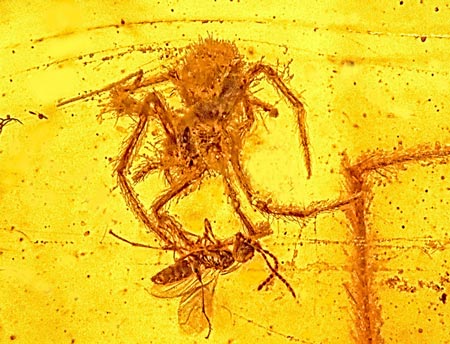100-million-year-old Spider Preserved In Amber as it Approached its Victim
Spider Attack Preserved in Amber
Researchers from Oregon State University (College of Science) have discovered a remarkable, 100-million-year-old spider fossil showing the moment when an orb spider approached its victim ensnared in its web. The fossil consists of the remains of the spider and a parasitic wasp, preserved in amber just as the spider was about to pounce upon the insect, as it was held fast by the silken threads of the spider’s web. Amber is the hardened remains of sticky, often scented resin that is produced by certain types of trees as protection against damage to bark and in order to help protect against disease and fungal attacks. Insects and other organisms can become trapped in the sticky resin as it flows down the trunk or branches and when fossilised and preserved as amber, these organic remains can be studied by scientists.
Trees first evolved the ability to produce resin of this nature in the Jurassic, but this piece of amber, discovered in the Hukawng Valley (also known as the Hukaung Valley), in northern Burma dates from the later Cretaceous geological period.
100-million-year-old Spider Fossil
The Hukaung Valley has been mined for amber and gold for many years, it has already produced a number of amber fossils containing insect remains. About ten years ago, the fossilised remains of the world’s oldest bee was discovered in an amber nodule from a mine in the Hukaung Valley. However, this is the first discovery of a predator/prey interaction concerning a spider and an insect trapped in a web. The amber nodule containing the fossilised remains has been dated to approximately 97-100 million years ago (Albian faunal stage of the Cretaceous) – a time when the dinosaurs ruled the Earth.
In addition to the first spider, the silk and the remains of the spider’s attempted meal, the wasp, the amber nodule also contained the remains of a second male spider. Scientists at the Oregon State University have interpreted this as evidence of social behaviour amongst arachnids. Most extant species of spider are solitary hunters, often they are cannibalistic towards their own kind, mature males and females will attack immature members of their own species. A number of species today show signs of social behaviour, living in colonies or aggregations.
The Oregon based team postulate that this fossil is evidence of such social, colonial activity in spiders back in the Cretaceous, the first evidence found of tolerance of other members of their own species by a spider.
The Spider About to Attack the Parasitic Wasp
Picture credit: Oregon State University.
Professor Emeritus of Zoology at Oregon State University, George Poiner Junior, a recognised authority on invertebrate fossils stated that:
“This juvenile spider was going to make a meal out of a tiny parasitic wasp, but never quite got to it. This was a male wasp that suddenly found itself trapped in a spider web. This was the wasp’s worst nightmare, and it never ended. The wasp was watching the spider just as it was about to be attacked, when tree resin flowed over and captured both of them.”
Over recent years, palaeontologists have discovered some amazing fossil specimens preserved in amber, from ancient Arthropods, to numerous types of insect, pollen, plant debris, even a frog, hairs from mammal and feathers from either an ancient bird or a dinosaur. Such fossils provide an insight into deep time, a micro world which helps scientists to understand more about ecosystems and habitats.
To read about the discovery of ancient spider silk: World’s Oldest Spiders Web Discovered Entombed in Amber.
To read an article about feathers preserved in amber: Canadian Palaeontologists in a Flap over Feathers.
The wasp has been identified as an ancestor of today’s parasitic wasps that attack and disable spiders and insects and lay their own eggs into the paralysed body of their victim or instead, parasitise the eggs of such creatures. The kind of spider preserved in the amber, a relative of today’s tropical orb spiders, but a member of an extinct genus would probably have been the sort of creature the wasp would have liked to attack.
As the research team members have stated in their press conferences, this fossil preserves the moment when a spider was able to turn the tables on a parasitic wasp. There were at least fifteen silken threads preserved in the amber nodule, evidence of the spider’s web. Some of these threads had trapped the wasp.
Both the spider and the wasp are scientifically described in an academic paper published in the journal “Historical Biology”.
For models and replicas of ancient invertebrates: CollectA Age of Dinosaurs Models (Popular).


